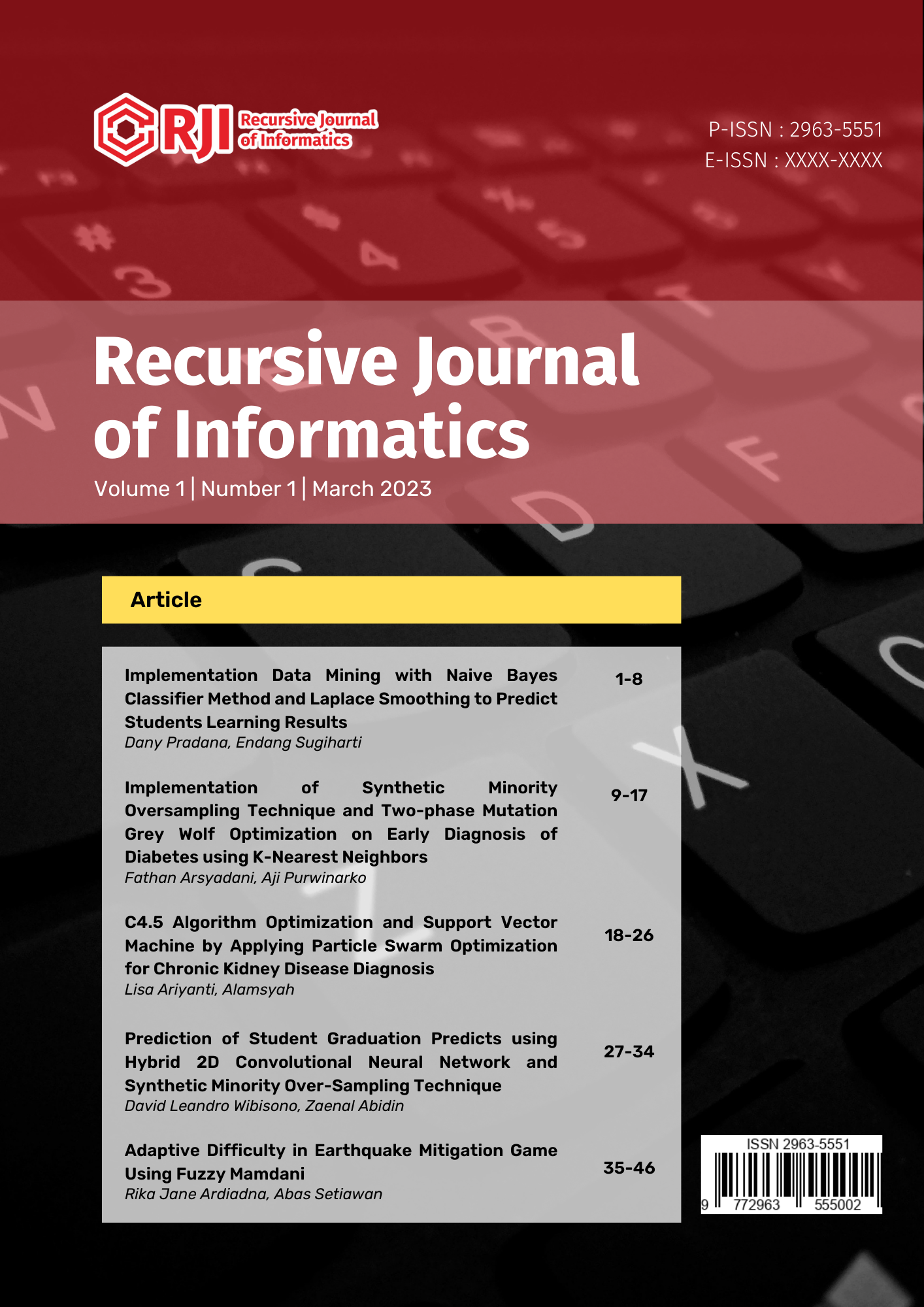Implementation of Synthetic Minority Oversampling Technique and Two-phase Mutation Grey Wolf Optimization on Early Diagnosis of Diabetes using K-Nearest Neighbors
Abstract
Abstract. Diabetes is a disease attacking the endocrine system characterized by high blood sugar levels. International Diabetes Federation (IDF) estimates that there were 451 million people with diabetes globally in 2017. Without treatment, this number is expected to rise to 693 million by 2045. One method for preventing increases in the number of diabetics is by early diagnosis. In an era where technology has developed rapidly, early diagnosis can be made with the machine learning method using classification. In this study, we propose a diabetes classification using K-Nearest Neighbors (KNN). Before classifying the data, we select the best feature subset from the dataset using Two-phase Mutation Grey Wolf Optimization (TMGWO) and balance the training data using Synthetic Minority Oversampling Technique (SMOTE). After dividing the dataset into training and testing sets using 10-fold cross validation, we reached an accuracy of 98.85% using the proposed method.
Purpose: This study aims to understand how to apply TMGWO and SMOTE to classify the early stage diabetes risk prediction dataset using KNN and how it affects the results.
Methods/Study design/approach: In this study, we use TMGWO to make a feature selection on the dataset, K-fold cross validation to split the dataset into training and testing sets, SMOTE to balance the training data, and KNN to perform the classification. The desired results in this study are accuracy, precision, recall, and f1-score.
Result/Findings: Performing classification using KNN with only features selected by TMGWO and balancing the training data using SMOTE gives an accuracy rate of 98.85%. From the results of this research, it can be concluded that the proposed algorithm can give higher accuracy compared to previous studies.
Novelty/Originality/Value: Implementing TMGWO to perform feature selection so the model can perform classification with fewer features and implementing SMOTE to balance the training data so the model can better classify the minority class. By doing classification using fewer features, the model can perform classification with a shorter computational time compared to using all features in the dataset.
References
[2] M. Pikkemaat, K. B. Boström, and E. L. Strandberg, “‘I have got diabetes!’ - Interviews of patients newly diagnosed with type 2 diabetes,” BMC Endocr Disord, vol. 19, no. 1, pp. 1–12, May 2019.
[3] J. J. Ofman et al., “Does disease management improve clinical and economic outcomes in patients with chronic diseases? A systematic review,” American Journal of Medicine, vol. 117, no. 3, pp. 182–192, Aug. 2004.
[4] S. Vijiyarani, S. Sudha, and M. P. Research Scholar, “Disease Prediction in Data Mining Technique-A Survey,” International Journal of Computer Applications & Information Technology, vol. 2, no. 1, p. 17, 2013.
[5] I. Kavakiotis, O. Tsave, A. Salifoglou, N. Maglaveras, I. Vlahavas, and I. Chouvarda, “Machine Learning and Data Mining Methods in Diabetes Research,” Comput Struct Biotechnol J, vol. 15, pp. 104–116, 2017.
[6] K. Pingale, S. Surwase, V. Kulkarni, S. Sarage, and A. Karve, “Disease Prediction using Machine Learning,” International Research Journal of Engineering and Technology (IRJET), vol. 6, no. 12, pp. 831–833, 2019.
[7] V. López, A. Fernández, S. García, V. Palade, and F. Herrera, “An insight into classification with imbalanced data: Empirical results and current trends on using data intrinsic characteristics,” Inf Sci (N Y), vol. 250, pp. 113–141, Nov. 2013.
[8] J. A. Sáez, B. Krawczyk, and M. Woźniak, “Analyzing the oversampling of different classes and types of examples in multi-class imbalanced datasets,” Pattern Recognit, vol. 57, pp. 164–178, Sep. 2016.
[9] T. Zhu, Y. Lin, and Y. Liu, “Synthetic minority oversampling technique for multiclass imbalance problems,” Pattern Recognit, vol. 72, pp. 327–340, Dec. 2017.
[10] V. Bolón-Canedo, N. Sánchez-Maroño, and A. Alonso-Betanzos, Feature Selection for High-Dimensional Data. Cham: Springer International Publishing, 2015.
[11] A. Destrero, S. Mosci, C. de Mol, A. Verri, and F. Odone, “Feature selection for high-dimensional data,” Computational Management Science, vol. 6, no. 1, pp. 25–40, 2009.
[12] M. Abdel-Basset, D. El-Shahat, I. El-henawy, V. H. C. de Albuquerque, and S. Mirjalili, “A new fusion of grey wolf optimizer algorithm with a two-phase mutation for feature selection,” Expert Syst Appl, vol. 139, pp. 1–14, 2020.
[13] L. Chaves and G. Marques, “Data mining techniques for early diagnosis of diabetes: A comparative study,” Applied Sciences (Switzerland), vol. 11, no. 5, pp. 1–12, Mar. 2021.
[14] D. H. Lee, J. K. Yang, C. H. Lee, and K. J. Kim, “A data-driven approach to selection of critical process steps in the semiconductor manufacturing process considering missing and imbalanced data,” J Manuf Syst, vol. 52, pp. 146–156, Jul. 2019, doi: 10.1016/j.jmsy.2019.07.001.
[15] S. Saxena, D. Mohapatra, S. Padhee, and G. K. Sahoo, “Machine learning algorithms for diabetes detection: a comparative evaluation of performance of algorithms,” Evol Intell, pp. 1–17, 2021.
[16] M. M. F. Islam, R. Ferdousi, S. Rahman, and H. Y. Bushra, “Likelihood Prediction of Diabetes at Early Stage Using Data Mining Techniques,” in International Symposium on Computer Vision and Machine Intelligence in Medical Image Analysis, 2019, pp. 113–125.
[17] T. M. Le, T. M. Vo, T. N. Pham, and S. V. T. Dao, “A Novel Wrapper-Based Feature Selection for Early Diabetes Prediction Enhanced with a Metaheuristic,” IEEE Access, vol. 9, pp. 7869–7884, 2020.









